Zigbee Sensors in FHEM

- ZigBee Communication without a proprietary Hub
- Adding our Sensors to FHEM
- Adding SQL Logging
- Compare with Data from Web-APIs
ZigBee Communication without a proprietary Hub
Zigbee is a specification for a suite of high-level communication protocols used to create personal area networks with small, low-power digital radios, such as for home automation, medical device data collection, and other low-power low-bandwidth needs, designed for small scale projects which need wireless connection. Hence, Zigbee is a low-power, low data rate, and close proximity wireless ad hoc network.
The Zigbee2MQTT bridge enables you to use selected supported ZigBee devices without the otherwise mandatory Hub and Vendor Cloud connection. Among the devices that you can control are smart (ZigBee) light bulbs from Belkin, IKEA, OSRAM and Philips as well as smart sensors from SmartThings and Xiaomi.
The ZigBee bridge consists of a ZigBee Sniffer Module and a controlling software written in Node.js. It bridges events and allows you to control your Zigbee devices via MQTT. In this way you can integrate your Zigbee devices with whatever smart home infrastructure you are using.
- CC debugger
- CC2531 USB sniffer
- Downloader cable CC2531
- PC or Raspberry Pi to run bridge
The Debugger, Sniffer and connecting cable can be ordered directly through online shops like AliExpress.
The debugger and cable are only used once to flash the firmware onto the stick. There is alternative way to do that using an Arduino board instead.
Setting up the bridge
- Install SmartRF Flash programmer (NOT V2). This software is free but requires a Texas Instruments account in order to download.
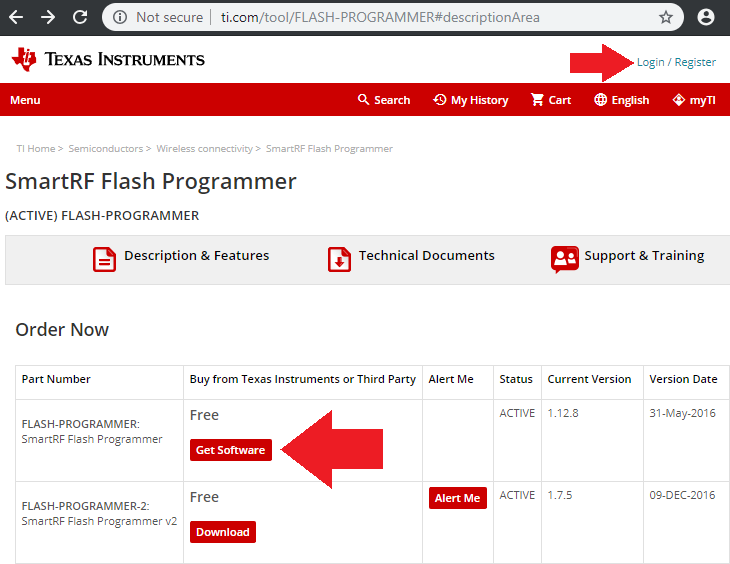
- Install the CC debugger driver on your PC (Windows only). Before continuing, verify that the CC Debugger driver has been installed correctly. In case the CC Debugger is not recognized correctly install the driver manually.
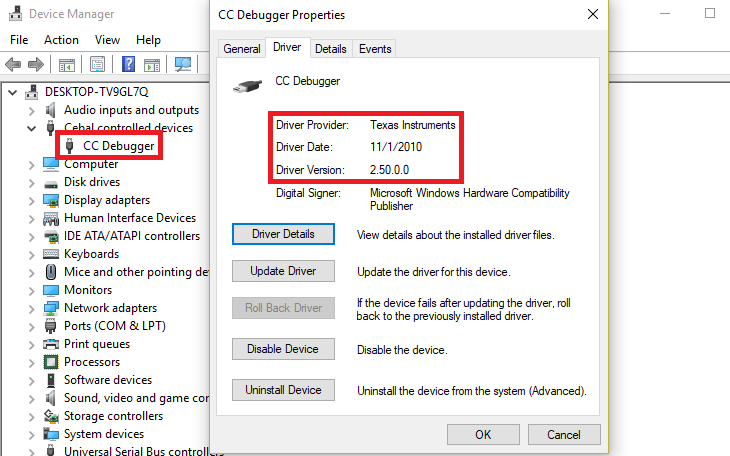
- Connect
CC debugger-->Downloader cable CC2531-->CC2531 USB sniffer.
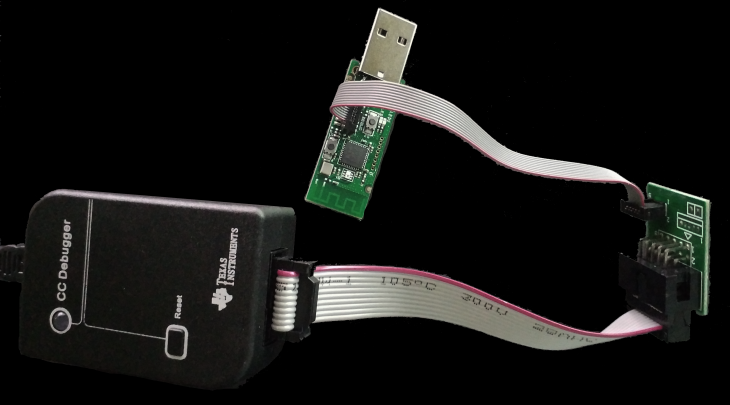
- Connect BOTH the
CC2531 USB snifferand theCC debuggerto your PC using USB. - If the light on the CC debugger is RED press set reset button on the CC debugger. The light on the CC debugger should now turn GREEN. If not use CC debugger user guide to troubleshoot your problem.
- Download and unzip the firmware CC2531ZNP-Prod.hex
- Start SmartRF Flash Programmer, setup as shown below and press
Perform actions.
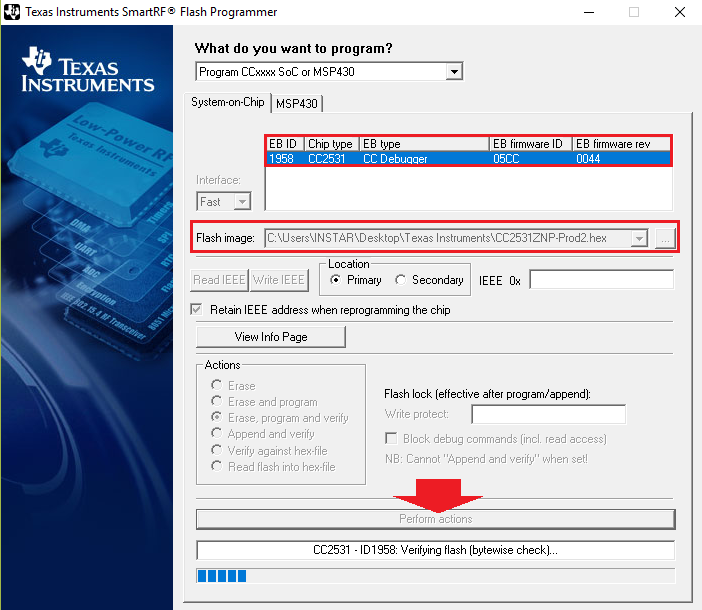
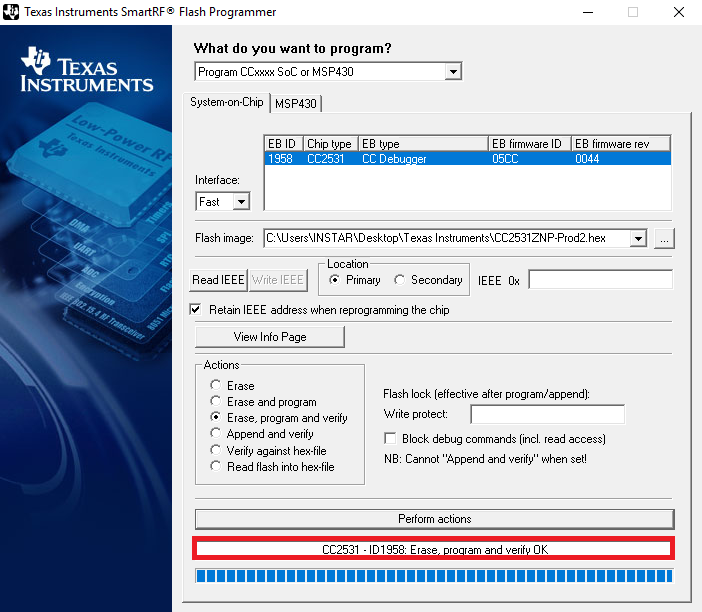
Running the bridge
After flashing your CC2531 USB sniffer with CC2531ZNP-Prod.hex firmware we can remove the CC Debugger and connecting cable and plug the Sniffer into our Linux computer you can use a Raspberry Pi 3 with Raspbian Stretch Lite, but will work on any Linux machine.
Determine location of CC2531 USB sniffer and checking user permissions
We first need to determine the location of the CC2531 USB sniffer. Connect the CC2531 USB to your Raspberry Pi. Most of the times the location of the CC2531 is /dev/ttyACM0. This can be verified by:
ls -l /dev/ttyACM0
crw-rw---- 1 root dialout 166, 0 Apr 21 13:14 /dev/ttyACM0 # <-- CC2531 on /dev/ttyACM0
As an alternative, the device can also be mapped by an ID. This can be handy if you have multiple serial devices connected to your pi. In the example below the device location is: /dev/serial/by-id/usb-Texas_Instruments_TI_CC2531_USB_CDC___0X00124B0018E32D5B-if00
ls -l /dev/serial/by-id
total 0
lrwxrwxrwx 1 root root 13 Apr 21 13:14 usb-Texas_Instruments_TI_CC2531_USB_CDC___0X00124B0018ED113B-if00 -> ../../ttyACM0

Installation
To use ZigBee2MQTT we first need to install Node.js and Git:
sudo apt update
sudo apt install git
You can confirm that you have installed Git and Node correctly by running the following commands:
git --version
node -v
Then clone ZigBee2MQTT from Github and change the owner of the /opt/zigbee2mqtt directory to your default Linux user - in our case this is nodeadmin:
sudo git clone https://github.com/Koenkk/zigbee2mqtt.git /opt/zigbee2mqtt
sudo chown -R pi:pi /opt/zigbee2mqtt
Then change into the directory and use npm to install all dependencies:
cd /opt/zigbee2mqtt
npm install

Configuration
Before we can start zigbee2mqtt we need to edit the configuration.yaml file. This file contains the configuration which will be used by zigbee2mqtt. Open the configuration file:
nano /opt/zigbee2mqtt/data/configuration.yaml

I am going to use a local Mosquitto MQTT server running on a INSTAR Full HD Camera on 192.168.2.115. Alternatively, you can install a local Mosquitto Server on your Raspberry Pi and add it via server: 'mqtt://localhost' in the config file.
# Home Assistant integration (MQTT discovery)
homeassistant: false
# allow new devices to join
permit_join: true
# MQTT settings
mqtt:
# MQTT base topic for zigbee2mqtt MQTT messages
base_topic: zigbee2mqtt
# MQTT server URL
server: 'mqtt://192.168.2.115'
# MQTT server authentication, uncomment if required:
# user: my_user
# password: my_password
# Serial settings
serial:
# Location of CC2531 USB sniffer
port: /dev/ttyACM0
I am not sure if Zigbee2MQTT offer TLS support - I will have to look into that. Also, I deactivated the user authentication on my MQTT server for now to have an easier time debugging - user name and password have to be added here before reactivating it.
Make sure that permit_join is set to true, to allow new devices to be added. It can be set to false once all your Zigbee devices are integrated.
For the serial port you can use the location of CC2531 USB sniffer that we determined to be either /dev/ttyACM0 or /dev/serial/by-id/usb-Texas_Instruments_TI_CC2531_USB_CDC___0X00124B0018ED113B-if00 - both can be used interchangeably (the location might differ in your case!).
Running ZigBee2MQTT
Now that we have setup everything correctly we can start zigbee2mqtt directly from our console to see if there are any error messages:
cd /opt/zigbee2mqtt
npm start
You should see the status LED on your CC2531 light up green and hopefully a friendly console log like this:
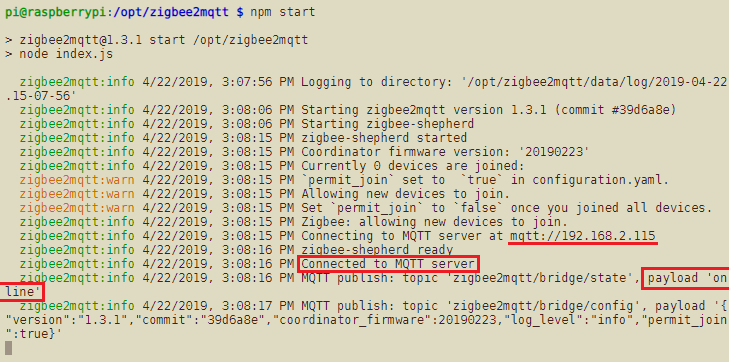
You can see that the service is running, connected to the local MQTT server and published a message to zigbee2mqtt/bridge/state with the payload online. We can use the program MQTT Explorer to verify that the message was received by our Mosquitto server:
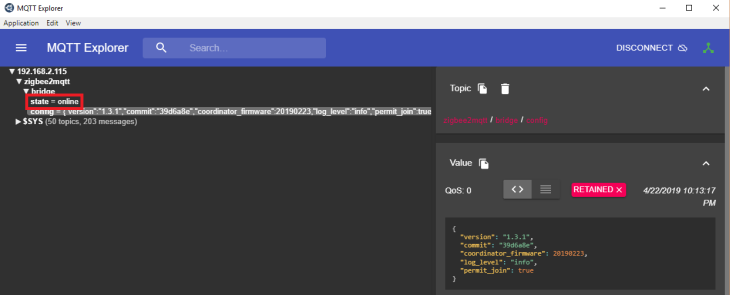
Looks like we were successful!
Running ZigBee2MQTT as a Daemon
To run zigbee2mqtt as a service and start it automatically on boot we will run zigbee2mqtt with systemctl:
sudo nano /etc/systemd/system/zigbee2mqtt.service
Add the following to this file to automatically run the index.js file from the zigbee2mqtt bridge inside the Node runtime:
[Unit]
Description=zigbee2mqtt
After=network.target
[Service]
ExecStart=/usr/bin/node /opt/zigbee2mqtt/index.js
StandardOutput=syslog
StandardError=syslog
SyslogIdentifier=zigbee2mqtt
Restart=always
# Restart service after 10 seconds if node service crashes
RestartSec=10
[Install]
WantedBy=multi-user.target
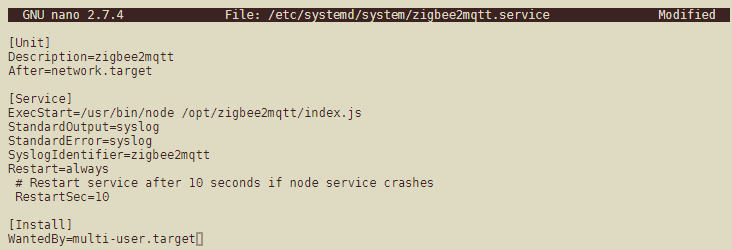
Save the file, exit and verify that the configuration works:
sudo systemctl daemon-reload
sudo systemctl start zigbee2mqtt
systemctl status zigbee2mqtt.service

Now that everything works, we want systemctl to start zigbee2mqtt automatically on boot, this can be done by executing:
sudo systemctl enable zigbee2mqtt.service
To stop, restart or check the log of our service run the following commands:
# Stopping zigbee2mqtt
sudo systemctl stop zigbee2mqtt
# Starting zigbee2mqtt
sudo systemctl start zigbee2mqtt
# View the log of zigbee2mqtt
sudo journalctl -u zigbee2mqtt.service -f
Update zigbee2mqtt to the latest version
# Stop zigbee2mqtt and go to directory
sudo systemctl stop zigbee2mqtt
cd /opt/zigbee2mqtt
# Backup configuration
cp -R data data-backup
# Update
git checkout HEAD -- npm-shrinkwrap.json
git pull
rm -rf node_modules
npm install
# Restore configuration
cp -R data-backup/* data
rm -rf data-backup
# Start zigbee2mqtt
sudo systemctl start zigbee2mqtt
Pairing Devices
The number of devices that you can use with the zigbee2mqtt bridge is steadily growing (there are alternative pairing instructions available here). In this tutorial we are going to add 3 XiaoMi Mi Home sensors - a Temperature & Humidity Sensor, a Wireless Switch and a Home Occupancy Sensor.
IMPORTANT: Before you start, make sure that permit_join: true is set in your configuration.yaml. Otherwise new devices cannot join the network! Also verify that the ZigBee2MQTT Bridge is running.
We first start with the Temperature & Humidity Sensor that has a pairing button on its side. Press the button for about 5 seconds - the blue LED will start to blink: in my case it started to blink slowly in 3-time sequences. After a few seconds the blinking sped up and stopped and the device was paired with the ZigBee Bridge.
The pairing can be found inside a log file in /opt/zigbee2mqtt/data/log/:
4/22/2019, 3:34:17 PM - info: New device 'undefined' with address 0x00158d00023a21c8 connected!
4/22/2019, 3:34:17 PM - info: MQTT publish: topic 'zigbee2mqtt/bridge/log', payload '{"type":"device_connected","message":"0x00158d00023a21c8","meta":{}}'
4/22/2019, 3:34:17 PM - warn: Device with modelID 'undefined' is not supported.
4/22/2019, 3:34:17 PM - warn: Please see: https://www.zigbee2mqtt.io/how_tos/how_to_support_new_devices.html
4/22/2019, 3:34:17 PM - info: MQTT publish: topic 'zigbee2mqtt/0x00158d00023a21c8', payload '{"temperature":29.63,"linkquality":134}'
4/22/2019, 3:34:17 PM - info: MQTT publish: topic 'zigbee2mqtt/0x00158d00023a21c8', payload '{"temperature":29.63,"linkquality":134,"humidity":60.12}'
4/22/2019, 3:35:05 PM - info: MQTT publish: topic 'zigbee2mqtt/0x00158d00023a21c8', payload '{"temperature":29.12,"linkquality":134,"humidity":60.12}'
4/22/2019, 3:35:05 PM - info: MQTT publish: topic 'zigbee2mqtt/0x00158d00023a21c8', payload '{"temperature":29.12,"linkquality":134,"humidity":57.13}'
4/22/2019, 3:35:08 PM - info: Device incoming...
4/22/2019, 3:35:08 PM - info: MQTT publish: topic 'zigbee2mqtt/bridge/log', payload '{"type":"pairing","message":"device incoming"}'
Shortly afterwards the sensor data started coming in:
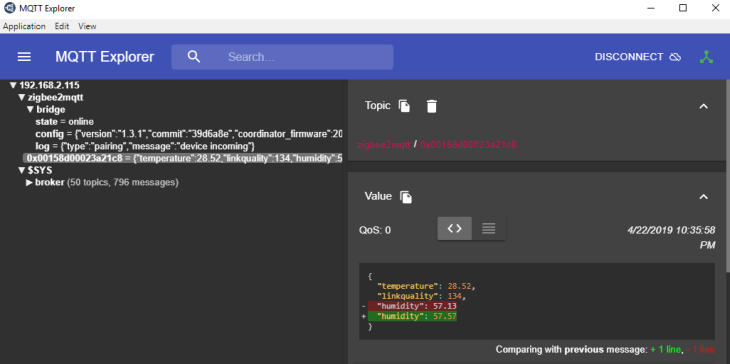
So far so good. But the device ID was a bit hard to read and memorize: 0x00158d00023a21c8. Luckily this can be adjusted in /opt/zigbee2mqtt/data/configuration.yaml:

All paired devices will be listed at the bottom of the configuration file - just change the friendly_name to something human-readable. Remember that this will also change the MQTT topic the Zigbee bridge is using to publish the sensor readouts:
info: MQTT publish, topic: 'zigbee2mqtt/temp_hum_sensor', payload: '{"temperature":26.33,"linkquality":78,"humidity":54.32,"battery":99,"voltage":3005}'
The topic changed from zigbee2mqtt/0x00158d00023a21c8 to zigbee2mqtt/temp_hum_sensor! Note: I thought I remembered that this worked without restarting the service - but this time it was necessary to do that ¯\(ツ)/¯
But pairing both the Wireless Switch and Home Occupancy Sensor turned out to be more difficult. Holding the pairing button - that here could only be reached with a metal pin - gave the same pattern. The blue LED started flashing - first slowly, then fast. But I kept getting timeouts for both devices - that identified as 0x00158d00023d229c and 0x00158d00020b3dff - for the pairing process inside the /opt/zigbee2mqtt/data/log/
error: Cannot get the Node Descriptor of the Device: 0x00158d00023d229c (Error: Timed out after 10000 ms)
error: Cannot get the Node Descriptor of the Device: 0x00158d00020b3dff (Error: Timed out after 10000 ms)
You can find an instruction that you need to press and hold the pairing button for 5 seconds (until the blue LED starts flashing), then release and keep pressing the button repeatedly (1s interval) afterwards - which feels a little bit counter-intuitive. But it actually works. Checking the log file shows that a Occupancy Sensor with the ID 0x00158d00020b3dff was connected:
4/22/2019, 3:55:03 PM - warn: Device with modelID 'undefined' is not supported.
4/22/2019, 3:55:03 PM - warn: Please see: https://www.zigbee2mqtt.io/how_tos/how_to_support_new_devices.html
4/22/2019, 3:55:41 PM - info: Device incoming...
4/22/2019, 3:55:41 PM - info: MQTT publish: topic 'zigbee2mqtt/bridge/log', payload '{"type":"pairing","message":"device incoming"}'
4/22/2019, 3:55:49 PM - info: MQTT publish: topic 'zigbee2mqtt/0x00158d00020b3dff', payload '{"occupancy":true,"linkquality":110}'
Repeating the same for the Wireless Switch and a new device with ID 0x00158d00023d229c showed up - excellent!
4/22/2019, 3:50:57 PM - info: New device 'undefined' with address 0x00158d00023d229c connected!
4/22/2019, 3:50:57 PM - info: MQTT publish: topic 'zigbee2mqtt/bridge/log', payload '{"type":"device_connected","message":"0x00158d00023d229c","meta":{}}'
4/22/2019, 3:50:57 PM - warn: Device with modelID 'undefined' is not supported.
4/22/2019, 3:50:57 PM - warn: Please see: https://www.zigbee2mqtt.io/how_tos/how_to_support_new_devices.html
4/22/2019, 3:50:58 PM - warn: Device with modelID 'undefined' is not supported.
4/22/2019, 3:50:58 PM - warn: Please see: https://www.zigbee2mqtt.io/how_tos/how_to_support_new_devices.html
4/22/2019, 3:51:28 PM - info: MQTT publish: topic 'zigbee2mqtt/0x00158d00023d229c', payload '{"click":"single","linkquality":102}'
Again, we can adjust that a human-readable name is displayed instead of the ID in /opt/zigbee2mqtt/data/configuration.yaml:
devices:
'0x00158d00023a21c8':
friendly_name: 'temp_hum_sensor'
retain: false
'0x00158d00023d229c':
friendly_name: 'smart_button'
retain: false
'0x00158d00020b3dff':
friendly_name: 'motion_pir_sensor'
retain: false
The new names will now be used for the corresponding MQTT topics:
4/22/2019, 3:55:49 PM - info: MQTT publish: topic 'zigbee2mqtt/motion_pir_sensor', payload '{"occupancy":true,"linkquality":110}'
4/22/2019, 3:57:19 PM - info: MQTT publish: topic 'zigbee2mqtt/motion_pir_sensor', payload '{"occupancy":false,"linkquality":110}'
4/22/2019, 3:59:11 PM - info: MQTT publish: topic 'zigbee2mqtt/temp_hum_sensor', payload '{"temperature":26.55,"linkquality":141,"humidity":60.77}'
4/22/2019, 3:59:12 PM - info: MQTT publish: topic 'zigbee2mqtt/temp_hum_sensor', payload '{"temperature":26.55,"linkquality":141,"humidity":54.63}'
4/22/2019, 4:00:10 PM - info: MQTT publish: topic 'zigbee2mqtt/smart_button', payload '{"linkquality":110,"duration":835,"click":"single"}'
4/22/2019, 4:00:17 PM - info: MQTT publish: topic 'zigbee2mqtt/smart_button', payload '{"linkquality":102,"duration":835,"click":"double"}'
4/22/2019, 4:00:19 PM - info: MQTT publish: topic 'zigbee2mqtt/smart_button', payload '{"linkquality":99,"duration":835,"click":"triple"}'
4/22/2019, 4:00:20 PM - info: MQTT publish: topic 'zigbee2mqtt/smart_button', payload '{"linkquality":102,"duration":835,"click":"quadruple"}'
4/22/2019, 4:00:23 PM - info: MQTT publish: topic 'zigbee2mqtt/smart_button', payload '{"linkquality":99,"duration":835,"click":"long"}'
4/22/2019, 4:00:24 PM - info: MQTT publish: topic 'zigbee2mqtt/smart_button', payload '{"linkquality":99,"duration":1094,"click":"long_release"}'
4/22/2019, 4:00:30 PM - info: MQTT publish: topic 'zigbee2mqtt/motion_pir_sensor', payload '{"occupancy":true,"linkquality":97}'
4/22/2019, 4:00:30 PM - info: MQTT publish: topic 'zigbee2mqtt/temp_hum_sensor', payload '{"temperature":27.73,"linkquality":141,"humidity":54.63}'
4/22/2019, 4:00:30 PM - info: MQTT publish: topic 'zigbee2mqtt/temp_hum_sensor', payload '{"temperature":27.73,"linkquality":141,"humidity":69.32}'
Note that the Occupancy Sensor sends a true or false payload depending on if motion was detected or not. The Temperature & Humidity Sensor just sends number values for temperature and humidity. And the Wireless Button sends click events and can discern between single, double, triple, quadruple and long / long_release clicks.
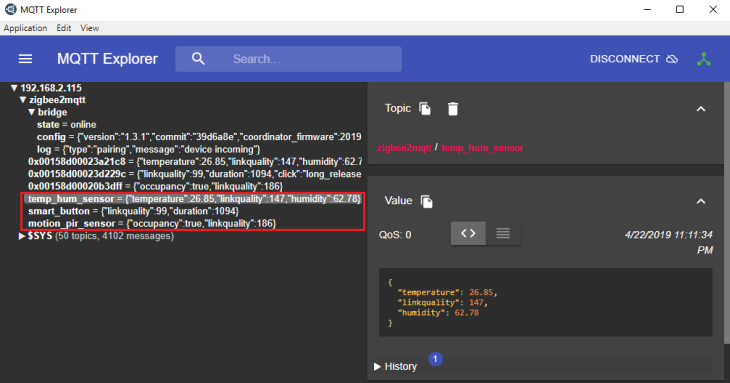
Adding our Sensors to FHEM
First we need to add a new module to FHEM that allows us to communicate with our Zigbee2MQTT Bridge:
update add https://raw.githubusercontent.com/oskarn97/fhem-xiaomi-mqtt/master/controls_xiaomi-zb2mqtt.txt
update check xiaomi-zb2mqtt
update all xiaomi-zb2mqtt
shutdown restart

Once FHEM is back up we can define the bridge module that will handle the communication for us:
define ZigbeeBridge XiaomiMQTTDevice bridge
Just a few seconds later we already start seeing readings coming in:
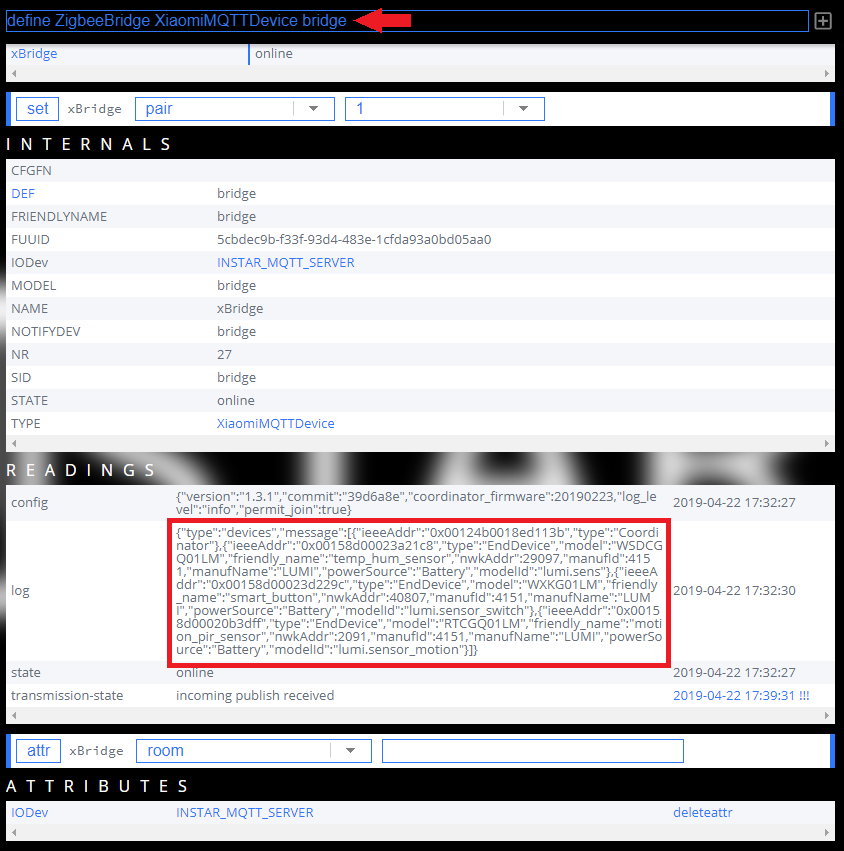
{
"type": "devices",
"message": [{
"ieeeAddr": "0x00124b0018ed113b",
"type": "Coordinator"
}, {
"ieeeAddr": "0x00158d00023a21c8",
"type": "EndDevice",
"model": "WSDCGQ01LM",
"friendly_name": "temp_hum_sensor",
"nwkAddr": 29097,
"manufId": 4151,
"manufName": "LUMI",
"powerSource": "Battery",
"modelId": "lumi.sens"
}, {
"ieeeAddr": "0x00158d00023d229c",
"type": "EndDevice",
"model": "WXKG01LM",
"friendly_name": "smart_button",
"nwkAddr": 40807,
"manufId": 4151,
"manufName": "LUMI",
"powerSource": "Battery",
"modelId": "lumi.sensor_switch"
}, {
"ieeeAddr": "0x00158d00020b3dff",
"type": "EndDevice",
"model": "RTCGQ01LM",
"friendly_name": "motion_pir_sensor",
"nwkAddr": 2091,
"manufId": 4151,
"manufName": "LUMI",
"powerSource": "Battery",
"modelId": "lumi.sensor_motion"
}]
}
Our sensors have been recognized through the FHEM connector - nice! And we have a new Room in our list called XiaoMiMQTTDevice holding all our sensors:
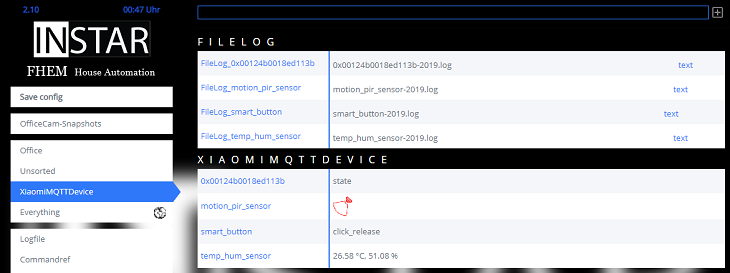
Adding SQL Logging
Installing MariaDB on our Raspberry Pi
We will start by installing the MariaDB (MySQL) Client and Server. Additionally, we need two Perl packages to be able to connect FHEM to the DB Client:
sudo apt-get update
sudo apt-get install mysql-server mysql-client
sudo apt-get install libdbi-perl libclass-dbi-mysql-perl
This should install and start your MariaDB instance. We can now continue to configure our database. By default the database can only be accessed by localhost - this might be perfectly fine (and is the secure option), but if you want to be able to access data on your Raspberry Pi from different computers we have to comment out the line bind-address = 127.0.0.1 inside:
sudo nano /etc/mysql/mariadb.conf.d/50-server.cnf
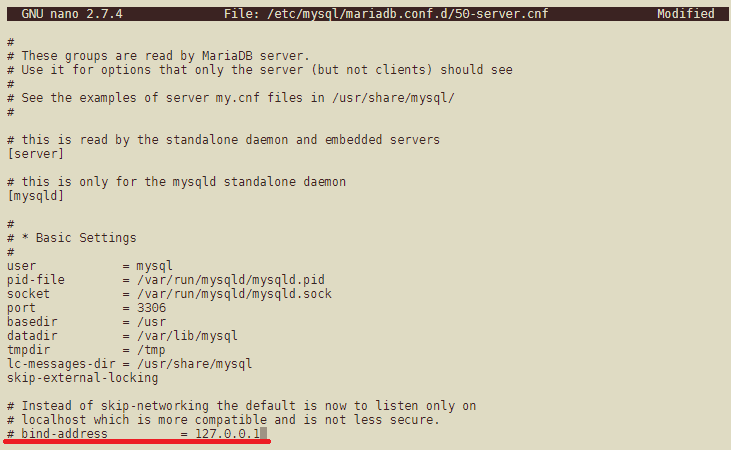
We can now enter our database with the following command (just press enter when asked for a password):
sudo mysql -u root -p
We will assign a new root password with the first line (see below - change the 'instar' string with your real password):
GRANT ALL PRIVILEGES ON *.* TO 'root'@'%' IDENTIFIED BY 'instar';
GRANT USAGE ON *.* TO 'root'@'%' WITH GRANT OPTION;
exit
For those change to take affect we now need to restart our SQL server sudo service mysql restart.
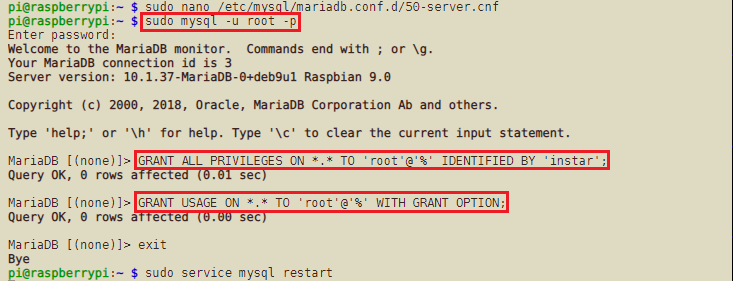
Configuring MariaDB for FHEM
We can now use a SQL Client, e.g. SQLElectron-GUI to further configure our database.
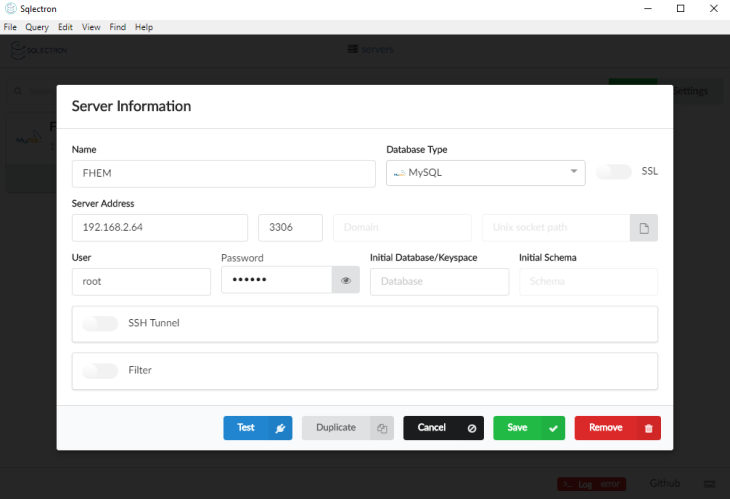
We are going to create a database called fhem as well as a user fhemuser with the login instar (change all of those at will) that will be used for our FHEM-generated data:
CREATE DATABASE `fhem` DEFAULT CHARACTER SET = `utf8`;
CREATE USER 'fhemuser'@'%' IDENTIFIED BY 'instar';
REVOKE CREATE ROUTINE, CREATE VIEW, CREATE USER, ALTER, SHOW VIEW, CREATE, ALTER ROUTINE, EVENT, SUPER, INSERT, RELOAD, SELECT, DELETE, FILE, SHOW DATABASES, TRIGGER, SHUTDOWN, REPLICATION CLIENT, GRANT OPTION, PROCESS, REFERENCES, UPDATE, DROP, REPLICATION SLAVE, EXECUTE, LOCK TABLES, CREATE TEMPORARY TABLES, INDEX ON *.* FROM 'fhemuser'@'%';
UPDATE mysql.user SET max_questions = 0, max_updates = 0, max_connections = 0 WHERE User = 'fhemuser' AND Host = '%';
GRANT CREATE ROUTINE, CREATE VIEW, ALTER, SHOW VIEW, CREATE, ALTER ROUTINE, EVENT, INSERT, SELECT, DELETE, TRIGGER, GRANT OPTION, REFERENCES, UPDATE, DROP, EXECUTE, LOCK TABLES, CREATE TEMPORARY TABLES, INDEX ON `fhem`.* TO 'fhemuser'@'%';
USE `fhem`;
CREATE TABLE `history` (
`TIMESTAMP` timestamp NOT NULL DEFAULT CURRENT_TIMESTAMP ON UPDATE CURRENT_TIMESTAMP,
`DEVICE` varchar(64) DEFAULT NULL,
`TYPE` varchar(64) DEFAULT NULL,
`EVENT` varchar(512) DEFAULT NULL,
`READING` varchar(64) DEFAULT NULL,
`VALUE` varchar(255) DEFAULT NULL,
`UNIT` varchar(32) DEFAULT NULL,
KEY `IDX_HISTORY` (`DEVICE`,`READING`,`TIMESTAMP`,`VALUE`),
KEY `DEVICE` (`DEVICE`,`READING`)
);
CREATE TABLE `current` (
`TIMESTAMP` timestamp NOT NULL DEFAULT CURRENT_TIMESTAMP ON UPDATE CURRENT_TIMESTAMP,
`DEVICE` varchar(64) DEFAULT NULL,
`TYPE` varchar(64) DEFAULT NULL,
`EVENT` varchar(512) DEFAULT NULL,
`READING` varchar(64) DEFAULT NULL,
`VALUE` varchar(255) DEFAULT NULL,
`UNIT` varchar(32) DEFAULT NULL
);

When successful, this will have created a database with the name fhem and two tables called current and history (For me the new table did not show up in SQLElecton right away after it was created. I disconnected, edited the database entry - see 2 screenshots up - and set the Initial Database to fhem. After reconnecting everything looked as it should):
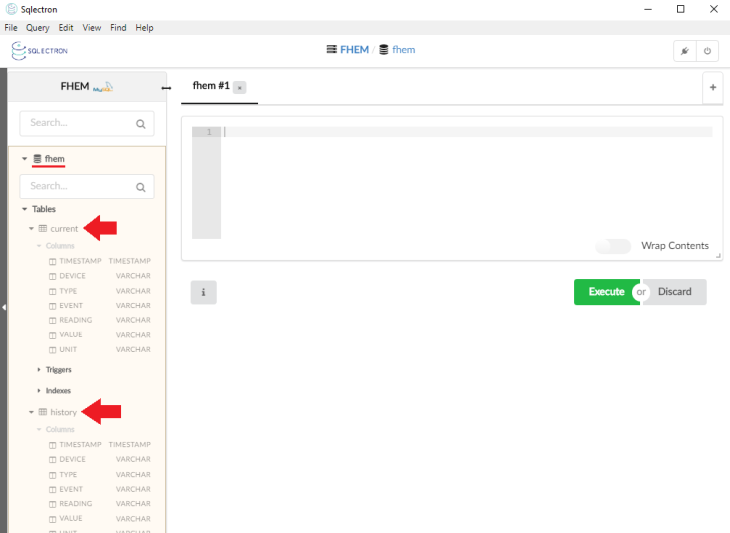
Let's now add our database to FHEM. We do this by copying the db.conf template to the FHEM root directory and editing the MySQL section:
sudo cp /opt/fhem/contrib/dblog/db.conf /opt/fhem/db.conf
sudo chown fhem:dialout /opt/fhem/db.conf
sudo nano /opt/fhem/db.conf
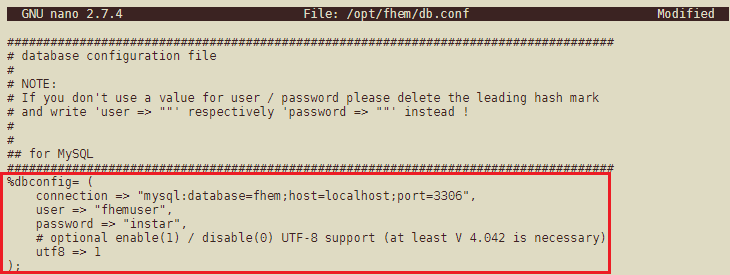
%dbconfig= (
connection => "mysql:database=fhem;host=localhost;port=3306",
user => "fhemuser",
password => "instar",
# optional enable(1) / disable(0) UTF-8 support (at least V 4.042 is necessary)
utf8 => 1
);
Now all we have to do is to tell FHEM to read the configuration file and start using our database setup to store all events:
define DBLogging DbLog /opt/fhem/db.conf .*:.*
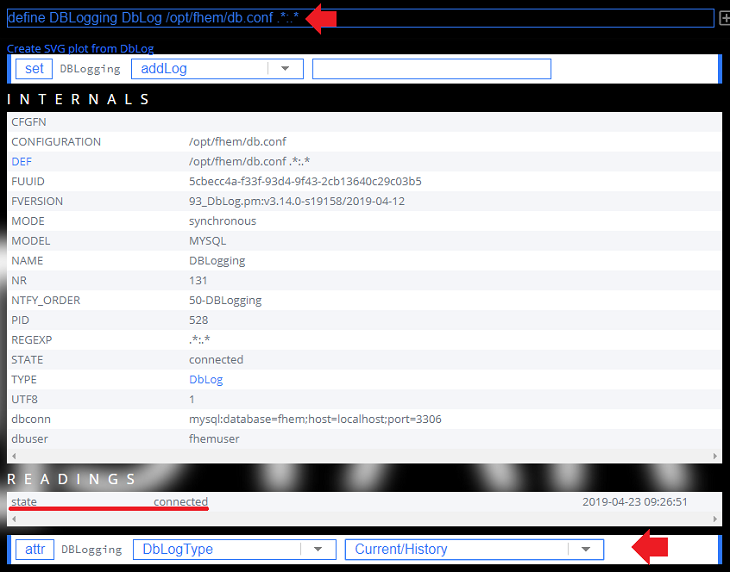
And don't forget to the set the DBLogType to Current/History (see bottom of the screenshot above). We can verify that the logging has started by querying the content of our Current Table:
SELECT * FROM current;
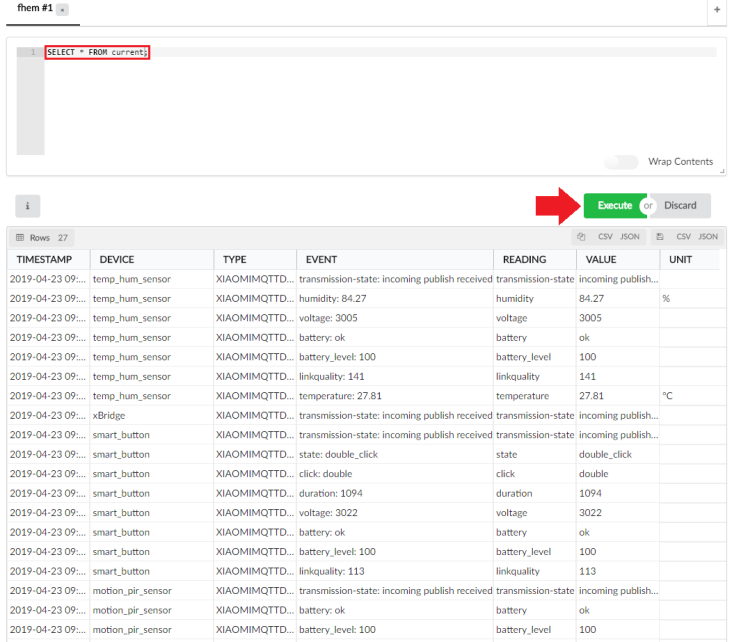
To make sure that the connection with your database is re-established if for whatever reason it fails, run the following command in FHEM: define DBLogging_Reopen at +*00:15:00 set DBLogging reopen.
Log Filter
We set up FHEM to log every event, which quickly leads to a huge pile of - mostly useless - data. You can check your current history with the followinf command:
SELECT DEVICE, COUNT(*) FROM history GROUP BY DEVICE ORDER BY 2 DESC;
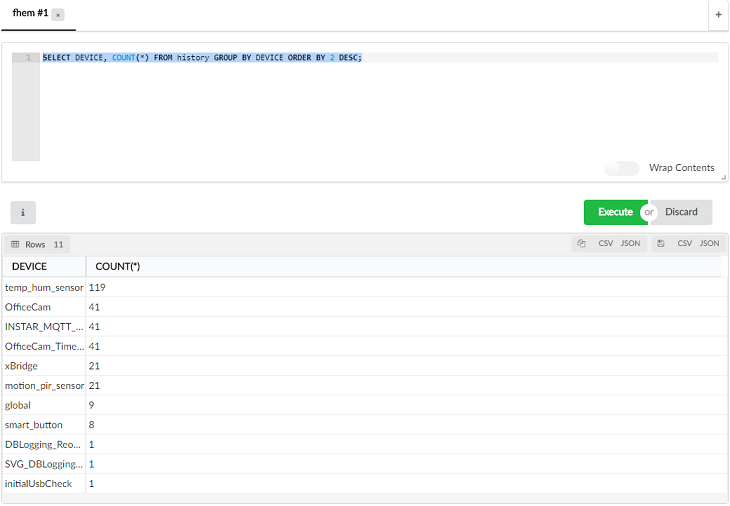
In my case only the temperature/humidity sensor and motion detector generates data that I want to use in later projects - the rest should be excluded. For this, we can go back to our DBLogging device in FHEM - http://<RaspiIP>:8083/fhem?detail=DBLogging and change the default DbLogSelectionMode to Exclude/Include:

- Exclude: DbLog behaves just as usual. This means everything specified in the regex in DEF will be logged by default and anything excluded via the DbLogExclude attribute will not be logged
- Include: Nothing will be logged, except the readings specified via regex in the DbLogInclude attribute (in source devices). Neither the Regex set in DEF will be considered nor the device name of the source device itself.
- Exclude/Include: Just almost the same as Exclude, but if the reading matches the DbLogExclude attribute, then it will further be checked against the regex in DbLogInclude whicht may possibly re-include the already excluded reading.
That means with Exclude/Include selected for our logging service we can now edit every device that is generating log entries and set attr <name> DbLogExclude .*:
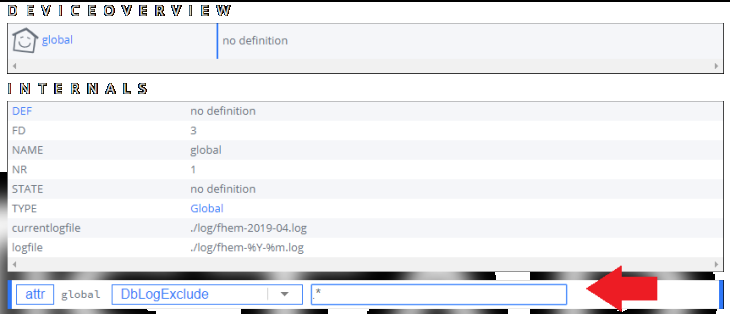
The regular expression .* includes everything and so nothing is logged anymore. Note: If you already have many devices included, simply use the following command to set this attribute for all your devices: attr .* DbLogExclude .*. To automate this for future devices use the following notify function:
define n_DbLogExclude notify global:DEFINED.* attr $EVTPART1 DbLogExclude .*
In a second step we can go in and use set attr <name> DbLogInclude <variable> to include selected variables for our log:
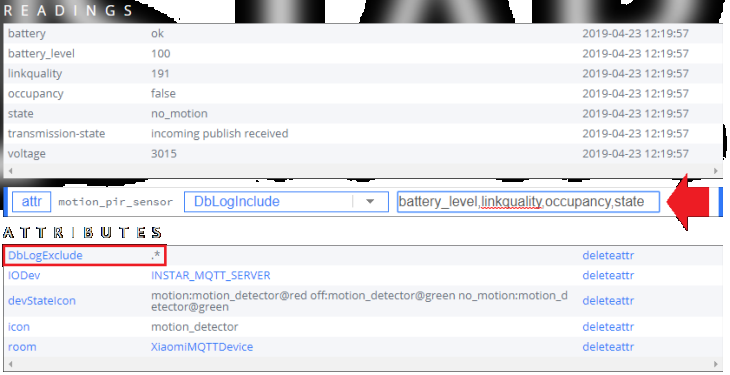
Average / Reduce
Additionally FHEM offers a Log reduction function that allows us to average every event that is older then n-days to only 1 event per hour:
set <name> reduceLogNbl <n> average
If we want to keep our data for 3 months this would be set DBLogging reduceLogNbl 90 average:
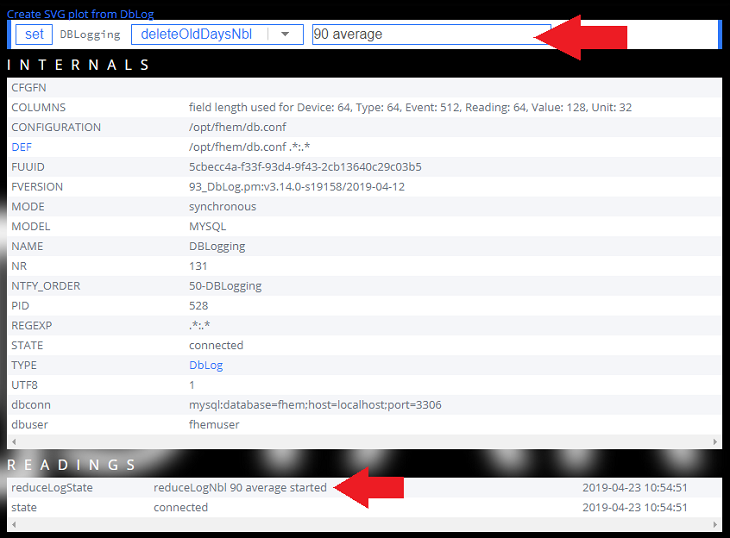
We can automate this in FHEM with:
define at_DbLoggingReduce at *04:30:00 set DBLogging reduceLogNbl 90 average
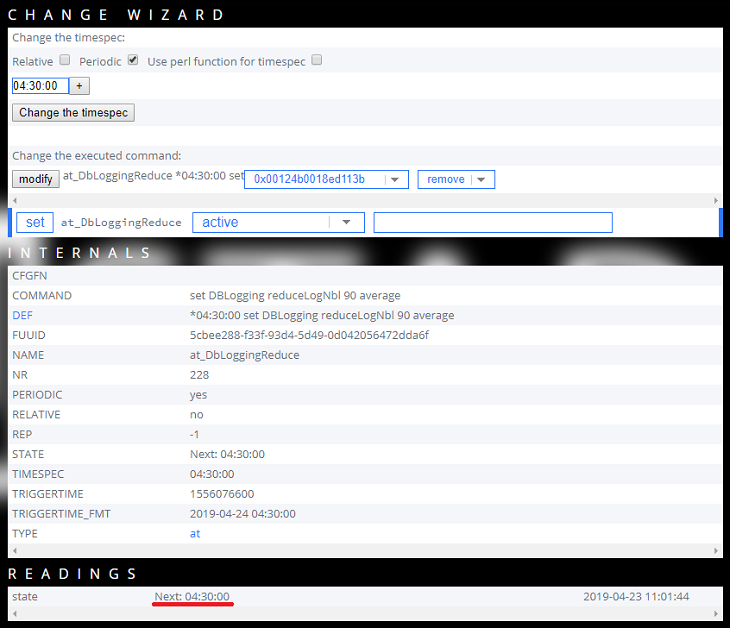
You can further reduce your data logs for entries older then 24hrs:
define DBLogging_Reduce at +*24:00:00 set DBLogging reduceLog 1
Compare with Data from Web-APIs
I now have a reading for the temperature inside my office - and might add a few more temperature sensors in the future. But it would be interesting to see how well the temperatures I measure fit the temperatures I can get from an online weather services like DarkSky.net. Click the link and select your city - you will find the coordinates that DarkSky assigns to your location inside the URL - in case of Shenzhen, China this is 22.5446,114.0545:
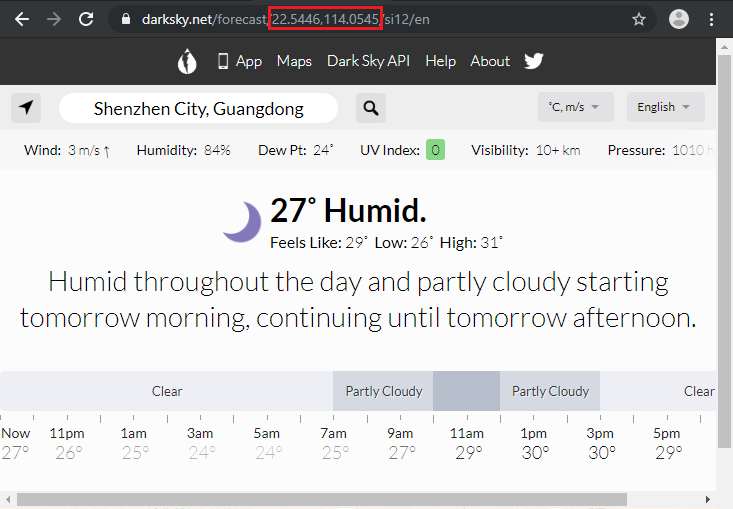
Once we know our ID we can start using the integrated weather module in FHEM to query the corresponding information for our location. Just make sure that your Raspberry Pi has the following Perl libraries installed so FHEM knows how to handle the API's JSON response (shutdown restart FHEM after the installation was successful):
sudo apt -y install libjson-perl libdatetime-format-strptime-perl
The command to add a weather device in FHEM then looks like this:
define <name> Weather [API=<API>[,<apioptions>]] [apikey=<apikey>] [location=<location>] [interval=<interval>] [lang=<lang>]
For me this results to define ShenZhenWeather Weather API=DarkSkyAPI,cachemaxage:600 apikey=09878945fdskv876 location=22.5446,114.0545 interval=3600 lang=en. Note: the API key inside this command does not work - you have to get your own free key by registering with DarkSky.
You should see your first reading coming in a few seconds later:

We can also output the data for a 7 day forecast on our FHEM interface by defining an HTML output:
define ShenZhenWeatherHtml weblink htmlCode {WeatherAsHtml("ShenZhenWeatherHtml",7)}
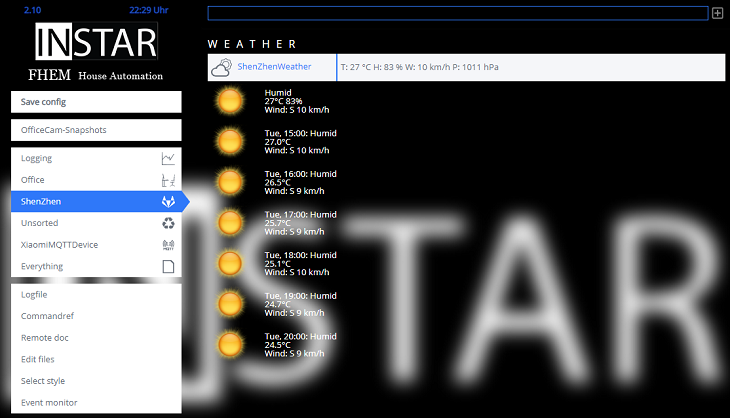
We can now reduce the amount of variables that we record by using event-on-update-reading, so by the next update I only receive (and log - see DbLogInclude) the following:
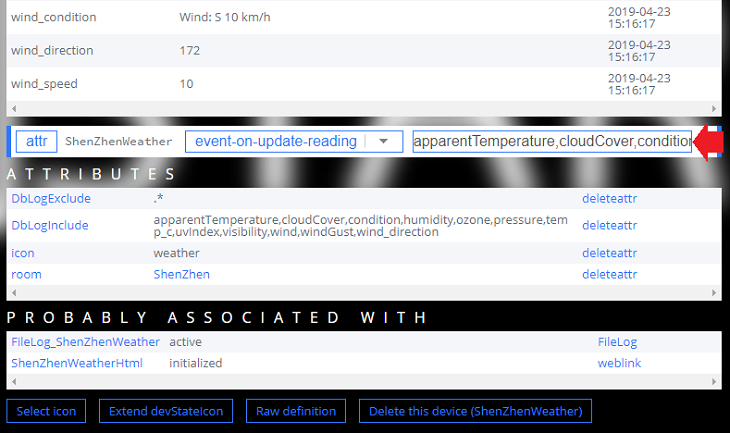
apparentTemperature,cloudCover,condition,humidity,ozone,pressure,temp_c,uvIndex,visibility,wind,windGust,wind_direction
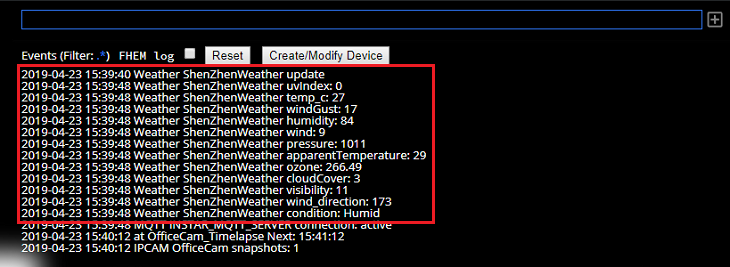
Visualize Logs
We can quickly write the API response to a log file:
define FileLog_ShenZhenWeather FileLog ./log/ShenZhenWeather-%Y.log ShenZhenWeather
You can check that the file is written with cat /opt/fhem/log/ShenZhenWeather-2019.log.

We can now use the integrated plot function to create a little SVG plot for our log:
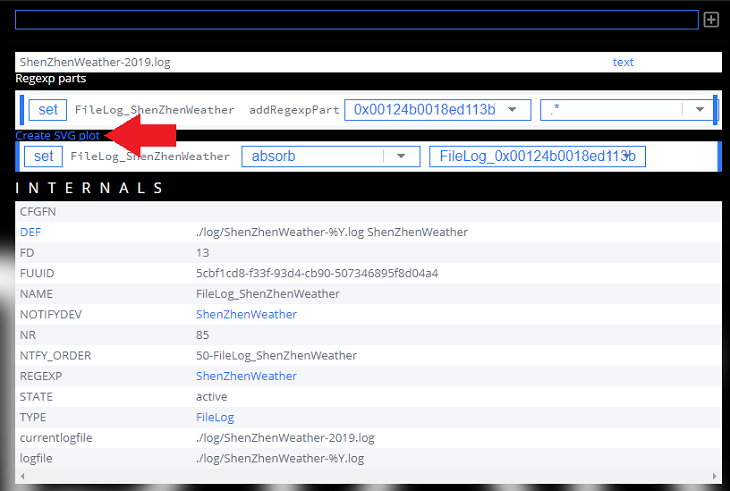
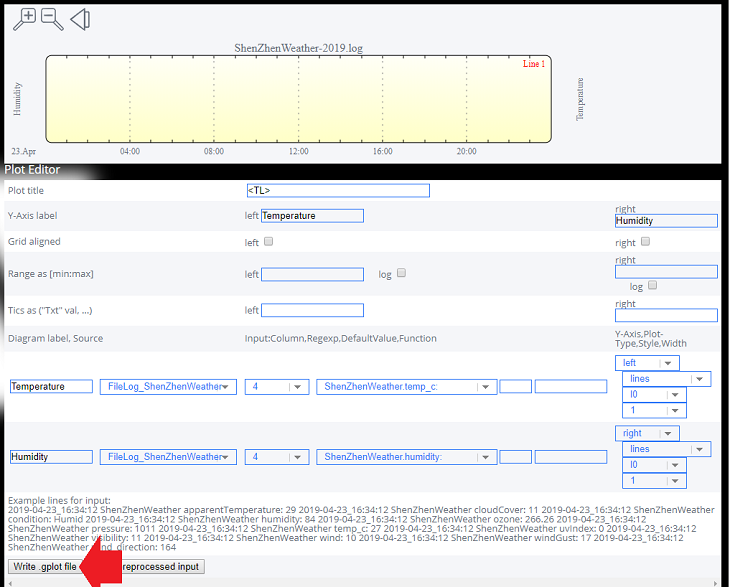
Generating the plot will add received data points to your plot. You can adjust the axis range and highlight colours to your need.
Going back to the ShenZhenWeather log definition, we can now also add the temperature and humidity reading from our XiaoMi sensor to the same log file:


And then go and add it to our plot - voilá :
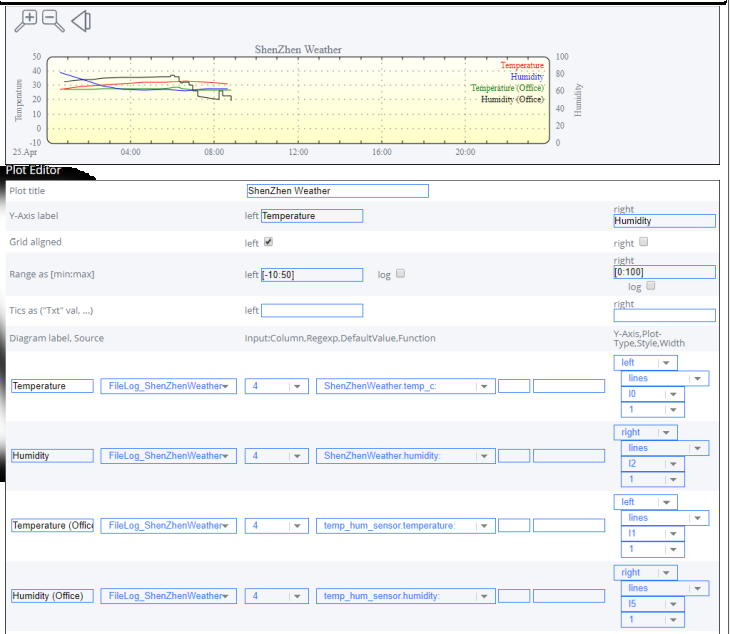
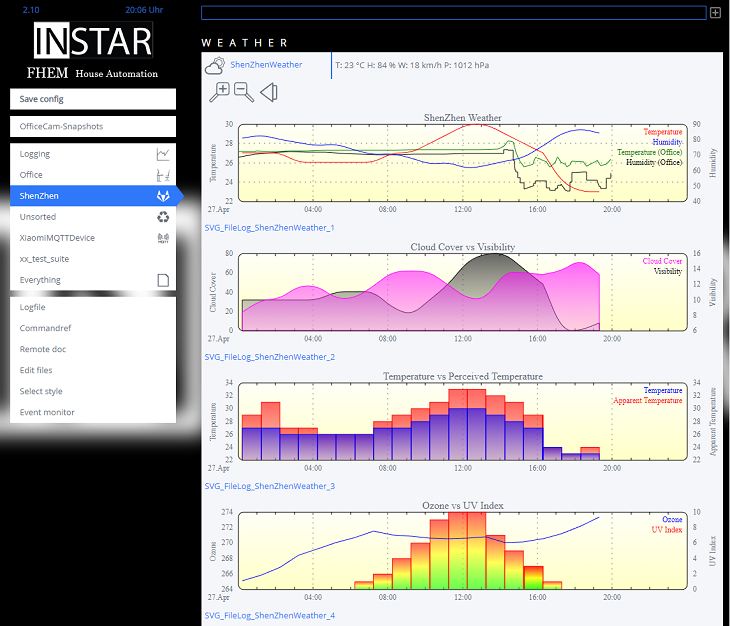
Using Zigbee Devices to control INSTAR IP Cameras in Node-RED
We now set up the Zigbee Bridge, connected Zigbee sensors and made sure that the messages are send to our Mosquitto MQTT server. We also found out the topics that our bridge uses for each sensors to publish its messages - zigbee2mqtt/motion_pir_sensor, zigbee2mqtt/temp_hum_sensor and zigbee2mqtt/smart_button - and what kind of payload to expect.
Now we can use the program MQTT.fx to verify that the message was received by our Mosquitto server:
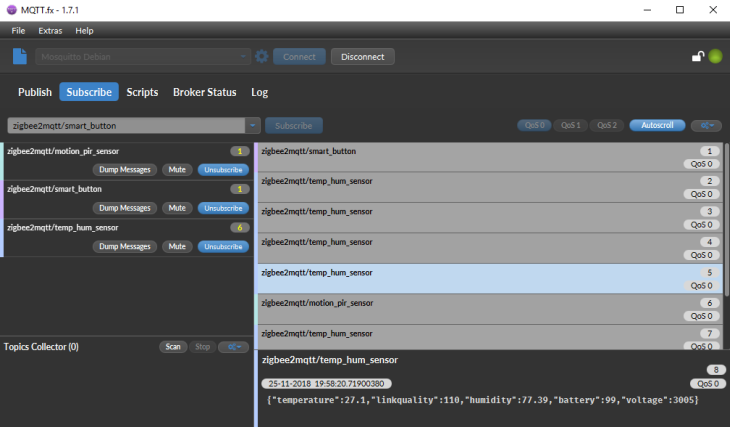
Every time the state changes the sensor will send a Zigbee message to our Bridge, which then forwards its payload to our Mosquitto server - perfect!
We can now start our Node-RED - that we either installed under Windows 10, on a Raspberry Pi or a Debian Linux Server, add MQTT Nodes and subscribe to all 3 MQTT topics:
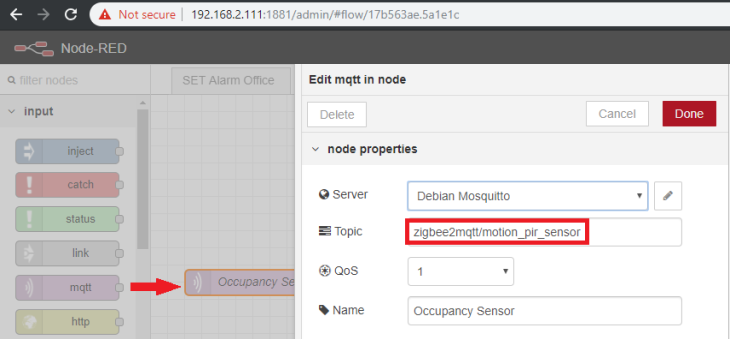
Connect all 3 of them to a Debug Node and deploy the flow. Click the button, warm up the temp sensor and trigger the motion detection - the MQTT messages will show up in the debug pane in Node-RED:

Add the MQTT input to an existing Flow
In the following sequence we are using the input for the wireless button to switch Alarm Areas on our cameras - we already used the same sequence for the Amazon Alexa Integration (the complete flow can be found in the Home Assistant Tutorial):
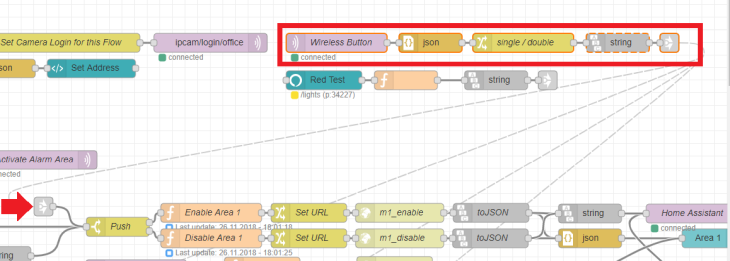
You can copy the following JSON code and import it into Node-RED (How do I import flows to Node-RED?):
[{"id":"ebde9a4c.90efe8","type":"link out","z":"17b43655.05bd3a","name":"","links":["57b22bf7.0e2874","5eb0d369.b3b15c","b5ce97db.b3f4f8","f335d7f4.4bbe18"],"x":1308,"y":100,"wires":[]},{"id":"accb31dd.a130c","type":"mqtt in","z":"17b43655.05bd3a","name":"Wireless Button","topic":"zigbee2mqtt/smart_button","qos":"1","broker":"40415d07.67dd94","x":780,"y":100,"wires":[["2537690e.6230d6"]]},{"id":"2537690e.6230d6","type":"json","z":"17b43655.05bd3a","name":"","property":"payload","action":"","pretty":false,"x":929,"y":100,"wires":[["17df313d.2e7aff"]]},{"id":"17df313d.2e7aff","type":"change","z":"17b43655.05bd3a","name":"single / double","rules":[{"t":"set","p":"payload","pt":"msg","to":"payload.click","tot":"msg"}],"action":"","property":"","from":"","to":"","reg":false,"x":1076,"y":100,"wires":[["1f97ee5b.dfc642"]]},{"id":"1f97ee5b.dfc642","type":"string","z":"17b43655.05bd3a","name":"","methods":[{"name":"replaceAll","params":[{"type":"str","value":"single"},{"type":"str","value":"{\"val\" : \"on\"}"}]},{"name":"replaceAll","params":[{"type":"str","value":"double"},{"type":"str","value":"{\"val\" : \"off\"}"}]}],"prop":"payload","propout":"payload","object":"msg","objectout":"msg","x":1226,"y":100,"wires":[["ebde9a4c.90efe8"]]},{"id":"40415d07.67dd94","type":"mqtt-broker","z":"","name":"Debian Mosquitto","broker":"localhost","port":"1883","clientid":"","usetls":false,"compatmode":true,"keepalive":"60","cleansession":true,"birthTopic":"","birthQos":"0","birthPayload":"","closeTopic":"","closePayload":"","willTopic":"","willQos":"0","willPayload":""}]
The MQTT Node outputs the message from our button as a string. We first have to turn it into a JavaScript Object with a JSON Node.
Next follows a Change Node that changes the Message Payload to the value of Click - as we learnt above, this value can either be single, double, triple, quadruple, long or release:
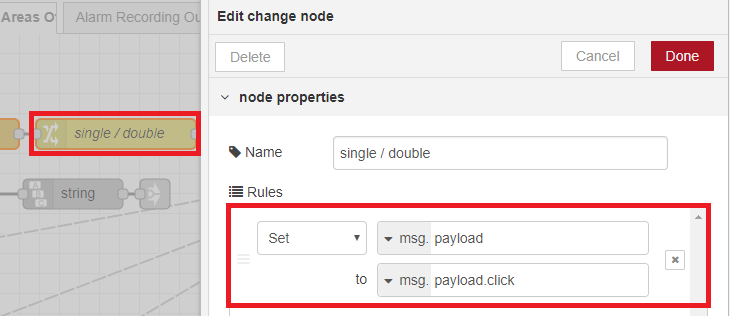
After that follows a String Node (this node type has to be installed manually - it is called node-red-contrib-string) that searches for the payload single or double and replaces them with something that we need to trigger the Flow below - in this case we need a JSON expression that either sets a value to on or off: {"val" : "on"} / {"val" : "off"}:
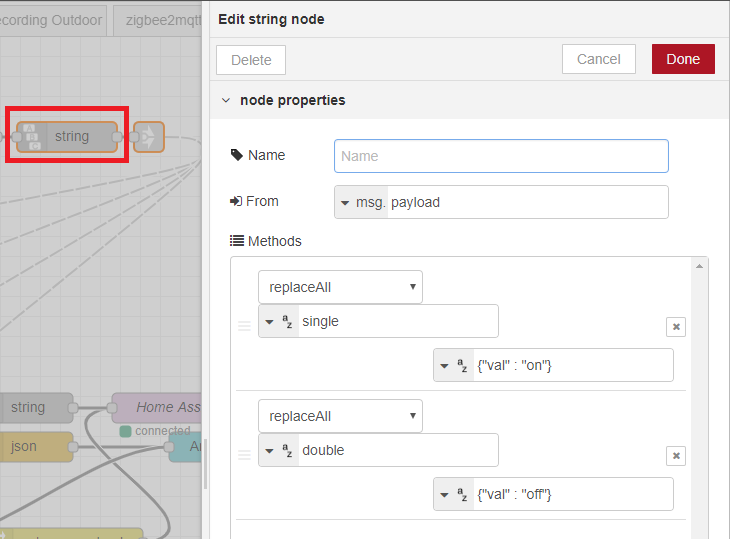
And last but not least we add a Link Node to plug it in to all 4 sequences for the for the 4 alarm areas. Now every time we single-click the Wireless Button all areas are activated. A double-click deactivates them:
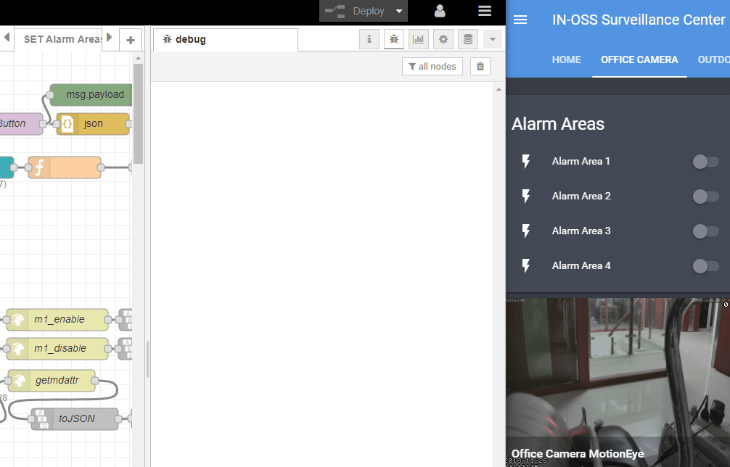
We attached a Debug Node to the MQTT input to visualize the input given by the Wireless Button - Note that only the single and double click trigger the Alarm Area Sequences - the rest of the input options can be used for other functions.